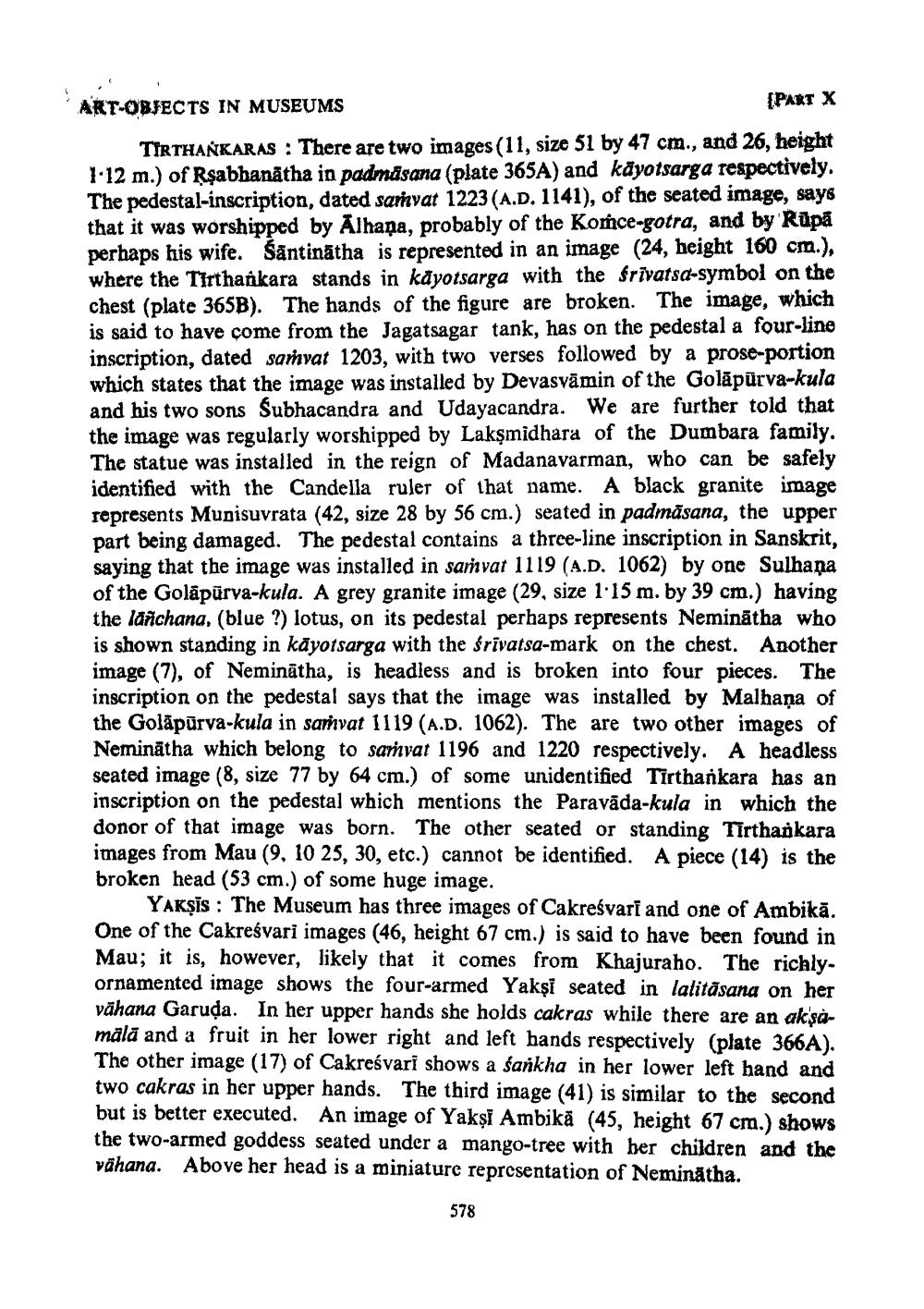________________
ART-OBJECTS IN MUSEUMS
[PART X
TIRTHANKARAS: There are two images (11, size 51 by 47 cm., and 26, height 1-12 m.) of Rsabhanatha in padmasana (plate 365A) and kayotsarga respectively. The pedestal-inscription, dated sarhvat 1223 (A.D. 1141), of the seated image, says that it was worshipped by Alhana, probably of the Komce-gotra, and by Rūpā perhaps his wife. Säntinätha is represented in an image (24, height 160 cm.), where the Tirthankara stands in kayotsarga with the frivatsa-symbol on the chest (plate 365B). The hands of the figure are broken. The image, which is said to have come from the Jagatsagar tank, has on the pedestal a four-line inscription, dated samvat 1203, with two verses followed by a prose-portion which states that the image was installed by Devasvämin of the Golāpūrva-kula and his two sons Subhacandra and Udayacandra. We are further told that the image was regularly worshipped by Lakşmidhara of the Dumbara family. The statue was installed in the reign of Madanavarman, who can be safely identified with the Candella ruler of that name. A black granite image represents Munisuvrata (42, size 28 by 56 cm.) seated in padmasana, the upper part being damaged. The pedestal contains a three-line inscription in Sanskrit, saying that the image was installed in sarhvat 1119 (A.D. 1062) by one Sulhana of the Golāpūrva-kula. A grey granite image (29, size 1.15 m. by 39 cm.) having the lanchana, (blue ?) lotus, on its pedestal perhaps represents Neminatha who is shown standing in kayotsarga with the śrivatsa-mark on the chest. Another image (7), of Neminatha, is headless and is broken into four pieces. The inscription on the pedestal says that the image was installed by Malhana of the Golāpūrva-kula in samvat 1119 (A.D. 1062). The are two other images of Neminatha which belong to sarhvat 1196 and 1220 respectively. A headless seated image (8, size 77 by 64 cm.) of some unidentified Tirthankara has an inscription on the pedestal which mentions the Paravada-kula in which the donor of that image was born. The other seated or standing Tirthankara images from Mau (9, 10 25, 30, etc.) cannot be identified. A piece (14) is the broken head (53 cm.) of some huge image.
YAKSIS: The Museum has three images of Cakreśvarf and one of Ambikā. One of the Cakreśvari images (46, height 67 cm.) is said to have been found in Mau; it is, however, likely that it comes from Khajuraho. The richlyornamented image shows the four-armed Yakşl seated in lalitäsana on her vähana Garuda. In her upper hands she holds cakras while there are an aksamälä and a fruit in her lower right and left hands respectively (plate 366A). The other image (17) of Cakreśvari shows a sankha in her lower left hand and two cakras in her upper hands. The third image (41) is similar to the second but is better executed. An image of Yakşl Ambika (45, height 67 cm.) shows the two-armed goddess seated under a mango-tree with her children and the vähana. Above her head is a miniature representation of Neminatha.
578




